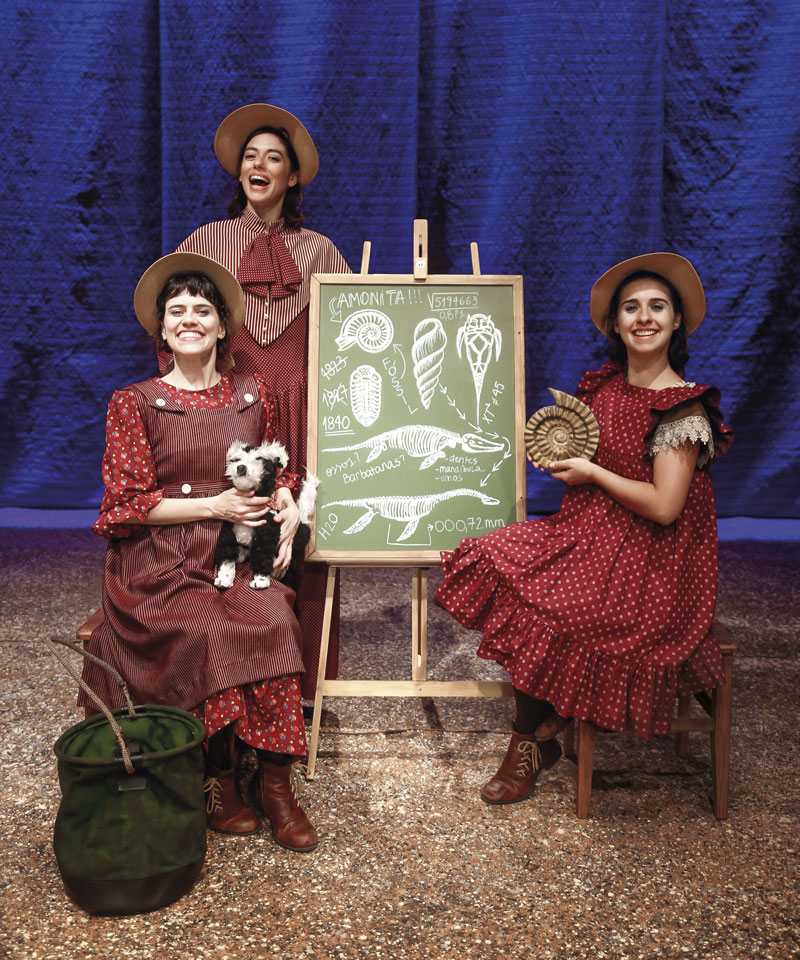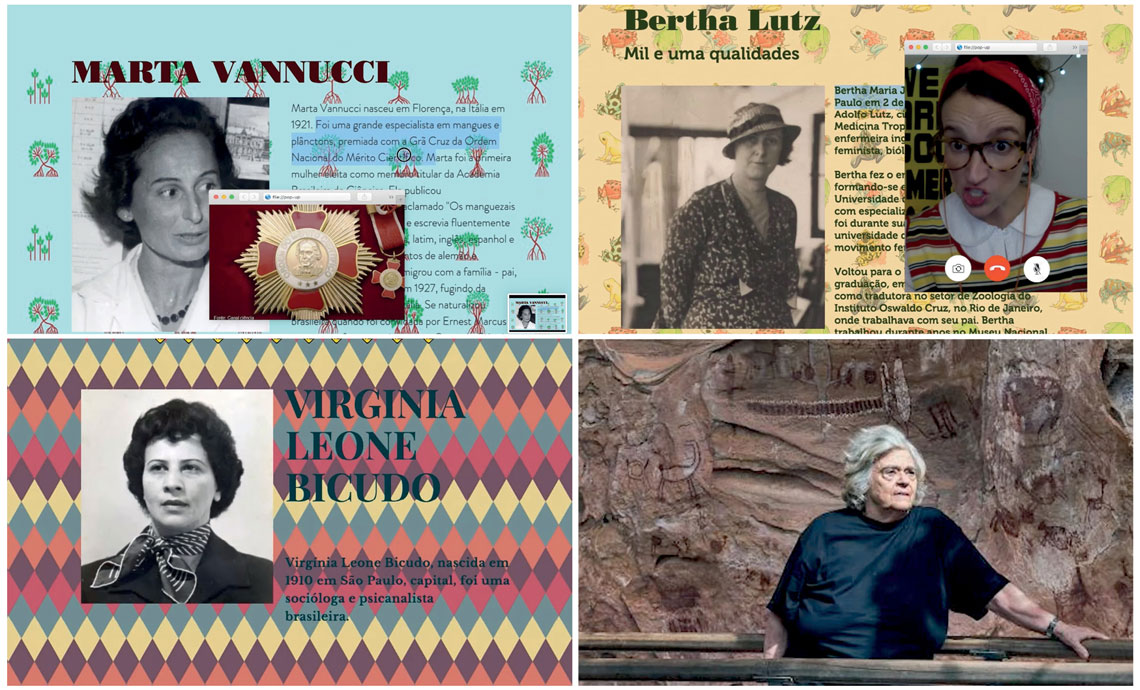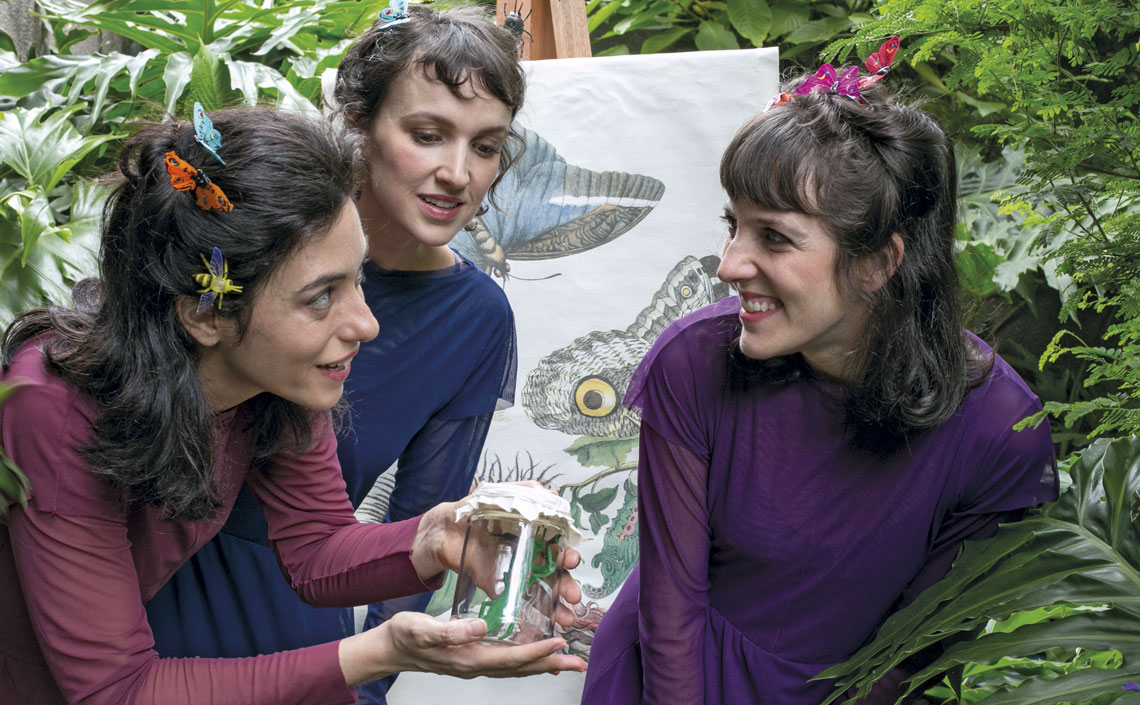
Maria Tuca FanchinActresses Thaís Medeiros, Julia Ianina, and Cecília Magalhães perform the play Mary e os monstros marinhos, about the English fossil hunter Mary AnningMaria Tuca Fanchin
When biologist and pedagogue Elaine Ferreira Machado received a message through Facebook from actress Thaís Medeiros, in 2019, she never imagined that it would be a proposal to see the subject of her research come to life on a theater stage and in a YouTube web series episode. Machado had spent five years studying the life and work of Maria Sibylla Merian (1647–1717), a German naturalist and scientific illustrator from the seventeenth century who published books about plants and insects with rich scientific detail. The way that art and science unite in the paintings was one of the factors that fascinated the researcher, who wrote her dissertation on the potential of Merian’s work for teaching science in schools. Later, it also attracted the actresses from Companhia Delas de Teatro, a theater company founded in 2001 by Medeiros and six female friends. Together, they decided to adapt the stories of Merian and other women in science for the stage and for YouTube in a way that was accessible not only for adults without biological science training, but also for children.
Olho mágico (Peephole) is a web series that only came to life due to the COVID-19 pandemic. Initially, all the stories had been thought of for the theater — a trilogy of biographies of European scientists told by Companhia Delas. Two plays had already hit the stages when the pandemic forced the closure of theaters in 2020. The project then moved onto YouTube with a very different format, and grew. With the success of the first videos, the three biographies turned into 10: three about Europeans, four about Brazilians, and three about researchers of different nationalities chosen for being ecologists. “The research began in theater and the first of all of them, Mary Anning, was an English woman because we wanted to enter the play for a public tender from Cultura Inglesa,” says Medeiros. “After we launched episodes based on our theater research, upon invitation by SESC Consolação, the idea arose of talking about women recognized for environmental action, and Itaú Cultural invited us to talk about Brazilian women,” recalls the actress.
From the world of female Brazilian researchers, archaeologist Niède Guidon, biologist and feminist activist Bertha Lutz (1894–1976), oceanographer Marta Vanucci (1921–2021), and sociologist and psychoanalyst Virgínia Leone Bicudo (1910–2003) were chosen. “We were telling stories from around the world and realized that Brazilian women are not mentioned very much, so we chose some and decided to break the trend of paying homage to women who have already died: we opened the series with Niède, who is alive,” remembers Medeiros. In addition to creating and writing scripts for the stories, the work of Campanhia Delas de Teatro is also linked to research. For some of the episodes of Olho mágico, the actresses sought help from experts.
The fossils used in the play are believable: they come from the USP laboratory of replicas
The web series premiered with Caroline Herschel (1750–1848), an astronomer who was the first woman to be paid as a scientist in the British court. The story of Englishwoman Mary Anning (1799–1847), “the greatest female fossil hunter in the world,” according to the company, was also adapted for the series based on the play they created in 2018. She lived in the nineteenth century and, aged 12, discovered the first ichthyosaur fossil, a marine reptile from 250 million years ago, and dedicated her life to discovering other fossils. “Her story is like a fairytale, it was really incredible and theatrical,” says actress Julia Ianina, one of the founders of Companhia Delas.
Everything was recorded individually with each actress in their home during the most critical period of isolation in 2020, in a format designed to be shown on the internet. The web series was entered into an emergency tender notice from the Municipal Department of Culture. “We opted for a different model from those in which people open the camera and start telling the stories. It was the easiest to make, but we decided on a production with editing, sound track, and visual effects,” comments actress Cecília Magalhães, another founder of the company.
The format and language are the differentials of the web series, which was awarded by the São Paulo Association of Art Critics (APCA) and became the object of analysis of Machado’s Art, Science, and Technology Research Group (GPACT) at the Federal Technological University of Paraná (UTFPR). In the article, the researchers classified Olho mágico as “theaweb,” a concept created by the research group itself for a work made for the internet but that uses knowledge, techniques, and culture from theater — the classification of the web series was only adopted later on. They also considered the work as a work of scientific dissemination that can be used as teaching material for young people of school age. “We had no intention of disseminating science, but we saw that we were doing it when scientists started seeing our stories and approaching us to comment,” says Medeiros.

ReproductionBrazilian personalities from the web series Olho mágico: sociologist and psychoanalyst Virgínia Leone Bicudo (1910–2003); Marta Vannucci (1921–2021), specialist in mangroves; Bertha Lutz (1894–1976), biologist and feminist activist; and Niède Guidon, archaeologist (below)Reproduction
Before the health emergency, the stories of Maria Sibylla Merian and Mary Anning occupied theater stages in São Paulo. Mary e os monstros marinhos (Mary and the sea monsters) premiered in 2018 and was awarded at the 22nd Cultura Inglesa Festival. Medeiros, Ianina, and Cecília Magalhães play the role of the fossil hunter, each in a phase of her life. To bring the character to life, they watched the classes of paleontologist Luiz Eduardo Anelli, of the University of São Paulo (USP), who later accompanied rehearsals and revised the scientific content of the play. “Our choices are artistic, so some metaphors required some poetic license, such as calling a fossil ‘petrified time’ or ‘a letter from the past to the future,’” says Ianina. The fossils used in the play are extremely believable; they come from the USP laboratory of replicas.
With the success of Mary Anning in the theater, the group created a new play, inspired by Merian. The naturalist was one of the first women to study the life cycles of insects and the process of metamorphosis of butterflies, as well as being a pioneer on a science expedition to the New World. In 1699, she traveled to Suriname, in South America, accompanied by her youngest daughter, Dorothea Maria, to observe, collect, and record species — 132 years before Charles Darwin (1809–1882). “There was very little about her in Portuguese, all her original work is in German,” says Elaine Machado. With the help of a colleague fluent in the language, she wrote her dissertation about the scientist-artist and, in 2018, published the article found by Medeiros in the scientific journal História da Ciência e Ensino, which was the starting point for producing Maria e os insetos (Maria and the insects). She acted as a consultant for the production of the play and was able to review the scientific content before it was performed.
“They were able to transform a scientific article into art. I became very emotional seeing it,” says the biologist, who is dedicated to studying the artistic language about biological sciences and the teaching of biology at GPACT. Machado saw the premier of Maria e os insetos in São Paulo in 2020. “They put poetry, music, and mannerisms into the character, which in no way detract from the scientific content, and don’t fall into stereotypes about scientific knowledge and scientists.”

Ligia JardimTo watch the web series Olho mágicoLigia Jardim
For Machado, it is important that the dissemination of science and biographies of researchers are done in a more accessible way. “The language of science is written for the peer audience, who can understand a scientific article, but it is not accessible to people untrained in that science, children, or adolescents,” she observes. According to Ianina, the language of theater helps address prickly and complex issues in an easier manner.
The greatest asset of works like that of Companhia Delas and other groups that address scientific topics in art is bringing the figure of the researcher and science closer to a wider audience. “Whether a movie, a series, or a theater play, the actors are able to personify the scientist, showing the human dilemmas of that character,” says Daniel Moura, a physicist and art educator at the São Paulo Federal Institute of Education, Science, and Technology (IFSP) who has been dedicated to studying scientific theater for almost 20 years. “There is a lot of science in art and vice versa, I cannot separate things that much,” he remarks.
According to Moura, works like those of Companhia Delas are part of an informal education: “Even though the producer of the play is not concerned about teaching or educating, a person may learn more from it than in a classroom.” For that reason, the researcher sees great value in the representation of diversity within scientific theater. “It is an extremely rich language, that can be worked on in several dimensions and show, for example, that science is diverse and not only made by white Europeans.” A writer and actor of more than 10 plays, Moura, who is Black, has already played physicist Isaac Newton (1643–1727) on stage. “A Black Isaac Newton wouldn’t happen in cinema, but theater permits this interpretation.”
With Olho mágico, Maria e os insetos, Mary e os monstros marinhos, and other creations, Companhia Delas hopes to inspire more girls and women to follow careers both in fields that are still more occupied by men, such as the production and teaching of science, and in the arts, such as theater or audiovisual. “These stories need to be told because they are stories of injustice,” says Medeiros. “These women did not get the recognition in life and they accomplished great things in the past, they lived for research and deserve this space.” Even with the web series having finished, Companhia Delas continues working to bring more science, art, and stories of female scientists to girls and women. The focus now is on the stage, and, soon, in the form of a podcast. Besides the award-winning web series, the company’s YouTube channel hosts another more recent one called Pergunte à cientista (Ask the scientist).
Scientific articles
MACHADO, E. F. et al. O theaweb “Olho Mágico”: Potencialidades para a divulgação científica e ensino de ciências. Educação Pública – Divulgação Científica e Ensino de Ciências. Online. mar. 2022.
MACHADO, E. F. et al. Maria Sibylla Merian: Uma mulher transformando ciência em arte. História da Ciência e Ensino. Online. jun. 30, 2018.